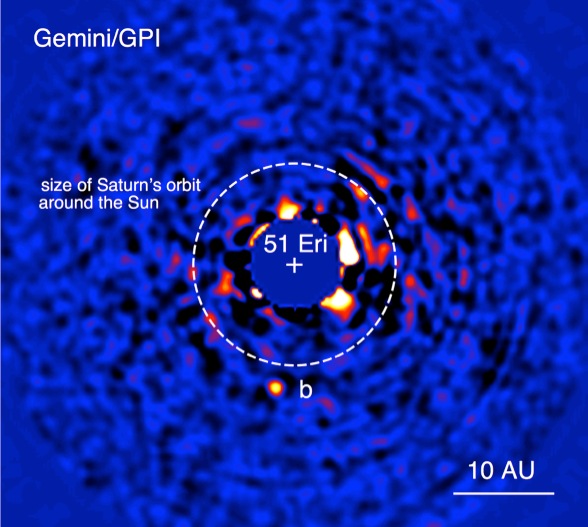Stephen Ammons (14-ERD-076)
Abstract
Direct studies of exoplanets with current technology has plateaued. Only the very youngest planets are visible in the infrared with released gravitational potential energy, and new capabilities are needed. The Gemini Planet Imager (GPI) is the most advanced astronomical adaptive-optics system in the world, dedicated to imaging and characterizing extrasolar planets. Lawrence Livermore led the construction of GPI and will have unique access to it when it becomes operational. We will lead the first-light and campaign science observations, and plan to develop tools to maximize GPI scientific yield such as planetary signal extraction and optimal campaign simulators. The GPI is also a unique tool for probing atmospheric turbulence and adaptive-optics control dynamics. Therefore, we will analyze its performance in detail to guide future high-performance adaptive-optics system programs—in particular, algorithms that predict atmospheric turbulence a few milliseconds into the future.
Adaptive optics is a key Laboratory competency for a variety of programmatic and scientific applications, including remote sensing, laser beam control, astronomy, and microscopy. Astronomical adaptive optics has long been the engine that drives this, providing high-visibility projects to strengthen outside collaborations, allowing testing of innovative approaches, and enabling recruitment of the best young scientists and engineers in this field. The GPI will be an order of magnitude more sensitive than any existing facility, and it will probe solar systems that are very different from those accessed by the National Aeronautics and Space Administration's Kepler mission. During first-light observations, we expect to characterize known planetary systems, determining the temperature and structure of young extrasolar giant planets and extrasolar asteroid and comet belts. We will produce a comprehensive performance budget for GPI. As the survey continues, we expect to discover 20 to 50 imaged extrasolar planets—enough to determine the frequency of solar systems resembling our own—with complete near-infrared spectra for 10 to 20 planets and estimates of their orbital eccentricity and period. In addition, we will perform on-sky testing of predictive control algorithms.
Mission Relevance
The high-contrast and high-performance techniques for adaptive optics developed here with the aid of predictive algorithms of atmospheric turbulence and GPI system simulations will be particularly applicable to space surveillance applications such as observations of targets requiring rapid telescope motion or faint sources close to bright targets. This work is relevant to the Laboratory's strategic focus area in cyber security, space, and intelligence to enhance situational awareness for space systems, as well as the core competency in high-performance computing, simulation, and data science.
FY15 Accomplishments and Results
In FY15 we (1) remotely participated in GPI runs for the larger science campaign; (2) used an archive of telemetry to improve GPI's reference centroid calibration sequence; (3) developed a Markov-chain Monte Carlo method for fitting orbits to planetary acceleration with a University of California, Berkeley, collaborator; (4) developed a simulation focused on space situational awareness of GPI for high-contrast observations; and (5) procured a diffractive mask for the GPI multiple-conjugate adaptive-optics system.
Discovery image of the "Jupiter-like" planet 51 Eridani b with the Gemini Planet Imager taken in near-infrared light. The bright central star has been mostly removed by a hardware and software mask to enable detection of the exoplanet, which is a million times fainter. Credit: J. Rameau (UdeM), C. Marois (NRC Herzberg), and SETI.
Publications and Presentations
- Barman, T. S., et al., “Simultaneous detection of water, methane, and carbon monoxide in the atmosphere of exoplanet HR 8799 b.” Astrophys. J. 804(1) (2015). LLNL-JRNL-678571.
- Jensen-Clem, R., et al., “Point source polarimetry with the Gemini Planet Imager: Sensitivity characterization with T5.5 dwarf companion HD 19467 B.” (2015). LLNL-JRNL-678637. http://arxiv.org/abs/1601.01353
- de Rosa, R. J., et al., “Astrometric confirmation and preliminary orbital parameters of the young exoplanet 51 Eridani b with the Gemini Planet Imager.” Astrophys. J. Lett. 814(3) (2015). LLNL-JRNL-678574.
- Hung, L. W., et al., “First scattered-light image of the debris disk around HD 131835 with the Gemini Planet Imager.” Astrophys. J. Lett. 815(1) (2015). LLNL-JRNL-678635.
- Kalas, P. G., et al., “Direct imaging of an asymmetric debris disk in the HD 106906 planetary system.” Astrophys. J. 814(32) (2015). LLNL-JRNL-678586.
- Macintosh, B., et al., “Discovery and spectroscopy of the young Jovian planet 51 Eri b with the Gemini Planet Imager.” Science 350(6256), 64 (2015). LLNL-JRNL-678639.
- Macintosh, B., et al., “First Light of The Gemini Planet Imager.” Proc. Natl. Acad. Sci. Unit. States Am. 111(35), 12661 (2015). LLNL-JRNL-678638.
- Millar-Blanchaer, M., et al., “β Pictoris' inner disk in polarized light and new orbital parameters for β Pictoris b.” (2015). LLNL-JRNL-678640. http://arxiv.org/abs/1508.04787
- Poyneer, L. A., et al., “Performance of the Gemini Planet Imager’s adaptive optics system.” Appl. Optic. 55(2), 323 (2015). LLNL-JRNL-677288.
- Wang, J. J., et al., “Gemini Planet Imager observations of the Au Microscopii debris disk: Asymmetries within one arcsecond.” Astrophys. J. Lett. 811(2) (2015). LLNL-JRNL-678601.






